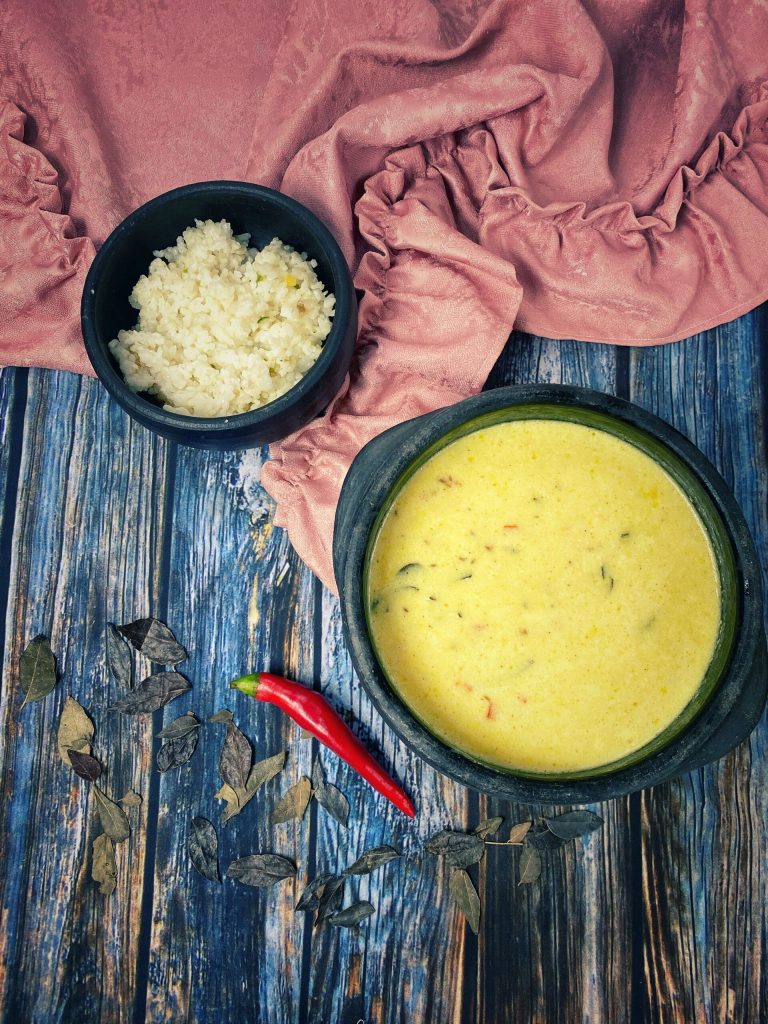The Kadhi, or karhi, is a yogurt-based (or buttermilk) dish originating from Rajasthan, India.
It is prepared by boiling yogurt with besan (chickpea flour) and Indian spices until a thick and spicy sauce is formed.
It is also often mixed with pakoras (fritters) or consumed with rice or roti.
The word Kadhi derives from the Sanskrit root kvathita (क्वथित) which refers to a decoction or a porridge of turmeric, asafoetida, and buttermilk.
The name kadhi also comes from various Indo-Aryan languages spoken in northern India, where काढ़ना kadhna means ‘to remove’, which, in this context, means to reduce, thus the yogurt and chickpea flour curry is cooked for a long time until it is reduced and the consistency changes from liquid to thick and creamy.
Although Punjab may have a strong association with kadhi-chawal, its origins trace back to Rajasthan, according to famous chef Kunal Kapur.
It is believed that kadhi originated in the arid landscapes of Rajasthan, where cooks incorporated dairy to compensate for limited vegetable availability.
Historically, kadhi was first made in Rajasthan before spreading to the regions of Gujarat and Sindh.
Chef Kunal explains that kadhi was traditionally prepared when families had excess milk, turning it into butter and leaving behind buttermilk (chaas) to use in the dish.
In Punjab, kadhi is a simple and quick winter meal.
Unlike the rest of India, yogurt can be added or not: it is possible to use whole buttermilk instead.
Depending on the region, it is commonly tempered with red chili, cumin, coriander seeds, asafoetida, and fenugreek seeds.
The following recipe is for Punjabi khadi.

- Difficulty: Easy
- Cost: Affordable
- Preparation time: 10 Minutes
- Portions: 4People
- Cooking methods: Boiling
- Cuisine: Indian
- Seasonality: All seasons
Ingredients
- 1.5 cups whole yogurt (or buttermilk)
- 1/3 cup besan (or chickpea flour)
- 2 red chilies
- to taste turmeric powder
- to taste garam masala
- to taste cumin
- to taste asafoetida
- 2 tsp fenugreek seeds
- 10 curry leaves
- to taste salt
Steps
Mix the yogurt or buttermilk with chickpea flour, add the chopped red chili, turmeric, and garam masala. Adjust salt and add 3 cups of water.
In a large pot, sauté in mustard oil the cumin, fenugreek seeds, asafoetida, curry leaves. Add the yogurt mix.
Thicken for about 20 minutes.
If you want to add the pakoras find the recipe on the blog.
You can serve with rice or roti.

If you decide to use yogurt, you can make it yourself with a yogurt maker.
Discover my review about the yogurt maker Moulinex YG231E Yogurteo
FAQ (Questions and Answers)
Who is Kunal Kapur?
Kunal Kapur (born September 18, 1979) is an Indian chef and restaurateur known for hosting and judging MasterChef India.
What are the Indian variants of kadhi?
Generally considered a staple everyday food in many parts of India, kadhi is believed to aid digestion.
In Gujarat and Rajasthan, it is usually served with khichdi, roti, paratha or rice.
The Gujarati kadhi is a bit sweeter than other variants because sugar or jaggery is added, but it can be made without sugar for a more tangy taste.
It is consumed without pakora, and its consistency is slightly thinner.
It can be prepared with buttermilk, giving it a smoother consistency than yogurt.
Variations of this basic dish include adding some vegetables, especially bhindi (okra): known as bhinda ni kadhi.
In western India, especially in the coastal area of Maharashtra and the Konkan region, it is prepared with kokum, creating a variant called solkadhi.
Other variants of kadhi in Maharashtra are made with kacchi kairi (raw mango), known as aambyachi kadhi (raw mango kadhi) or with curd and buttermilk, and this is known as takachi kadhi.
In Haryana, a popular variant is called haryanvi hara choley kadhi, made with besan and hare choley (raw green chickpeas) plus pure clarified butter.
Haryanvi kadhi is sometimes cooked with additional ingredients, like fresh seasonal Bathua green leaves or kachri, a type of small wild melon.
In Purvanchal (eastern Uttar Pradesh) and Bihar, it is called kadhi-badi due to the addition of pakora, small badi (or vada) made with chickpea flour, without adding vegetables.
In the southern states, it is tempered with sautéed asafoetida, mustard seeds, cumin, and fenugreek.
The soup is thickened differently by adding pureed split chickpeas soaked overnight with whole coriander seeds and dry red chili.
Pumpkin, okra, tomato, Chinese spinach, carrots, and sweet peas are some of the vegetables that are added to the tempering before bringing the soup to a boil.
Pakoras are added for special occasions such as ceremonies.
The Sindhi diaspora in India usually prepares kadhi by roasting chickpea flour and adding vegetables to the chickpea sauce.
It is called kadhi for the use of curry leaves, known as kadhi patta in Sindhi.
Instead of yogurt, tamarind pulp is used to give it a sour taste.
An alternative method is to prepare a liquid mixture of chickpea flour instead of roasting the chickpeas.

